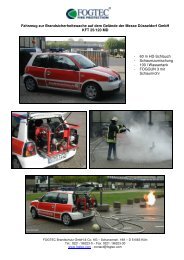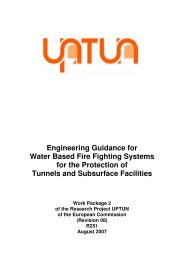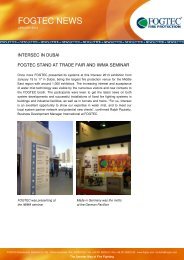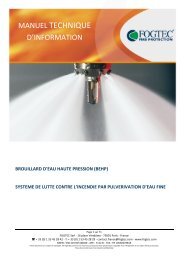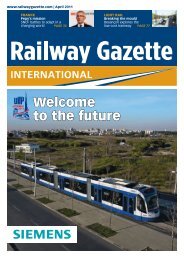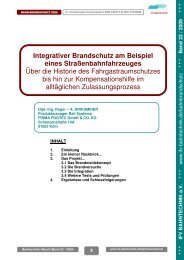Fixed Fire Fighting Systems for Road and Rail Tunnels - FOGTEC
Fixed Fire Fighting Systems for Road and Rail Tunnels - FOGTEC
Fixed Fire Fighting Systems for Road and Rail Tunnels - FOGTEC
Create successful ePaper yourself
Turn your PDF publications into a flip-book with our unique Google optimized e-Paper software.
1<br />
February<br />
Offizielles Organ der STUVA · Official Journal of the STUVA<br />
2012<br />
www.tunnel-online.info<br />
Austria / Italy: Brenner Base Tunnel under Construction<br />
Driving Technology: Extension of Prague Metro<br />
<strong>Fire</strong> Safety: <strong>Fixed</strong> <strong>Fire</strong> <strong>Fighting</strong> <strong>Systems</strong>
40 Br<strong>and</strong>schutz<br />
<strong>Fire</strong> Safety<br />
Tunnel 1/2012<br />
1<br />
Activation of FFFS in the commissioning<br />
test of M30 tunnels in Madrid, Spain [8]<br />
<strong>Fixed</strong> <strong>Fire</strong> <strong>Fighting</strong> <strong>Systems</strong> <strong>for</strong> <strong>Road</strong><br />
<strong>and</strong> <strong>Rail</strong> <strong>Tunnels</strong><br />
Today, fixed fire fighting systems (FFFS) are an established technology to<br />
improve safety in tunnels. The following article – a lecture at the STUVA<br />
Conference 2011 in Berlin - gives an overview of FFFS technology in general<br />
<strong>and</strong> also highlights requirements posed on operation, testing, design<br />
<strong>and</strong> installation. Additionally 2 case studies – the Eurotunnel <strong>and</strong> the Tyne<br />
<strong>Tunnels</strong>, – are described in this article.<br />
1 <strong>Fixed</strong> <strong>Fire</strong> <strong>Fighting</strong> <strong>Systems</strong><br />
(FFFS) in <strong>Tunnels</strong><br />
1.1 Introduction<br />
<strong>Fixed</strong> fire fighting systems (FFFS)<br />
are an active way of combating<br />
fires in tunnels (Fig. 1). They are<br />
a new method of improving fire<br />
safety compared to conventional<br />
technologies such as passive<br />
protection <strong>and</strong> ventilation.<br />
The approach using active fire<br />
Dipl.-Ing. Max Lakkonen; Dipl.-Ing. Till Bremke,<br />
Fogtec <strong>Fire</strong> Protection, Cologne/D<br />
fighting as a fixed installation has<br />
been employed <strong>for</strong> decades in<br />
Australia <strong>and</strong> Japan. The technology<br />
was selected in accordance<br />
with building protection rules;<br />
low-pressure deluge systems<br />
have been applied. The European<br />
approach has been to apply<br />
water mist fire fighting technology,<br />
which has been in commercial<br />
use <strong>for</strong> only 20 years, initially<br />
in marine applications <strong>and</strong> now<br />
in most applications. Water mist<br />
technology was first found to<br />
be extremely effective against<br />
tunnel fires within the UPTUN<br />
research project [1]. Later, it<br />
was shown in full-scale fire tests<br />
within the SOLIT <strong>and</strong> SOLIT2 research<br />
projects that high-pressure<br />
water mist technology is very<br />
effective against heavy goods<br />
vehicle fires in tunnels [2]. HGV<br />
fires are normally used as the design<br />
criterion since the aftermath<br />
of catastrophic fires has shown<br />
how severe they can be. Highpressure<br />
water mist systems<br />
have become a well-established<br />
technology based on European<br />
research programmes <strong>and</strong> a<br />
number of privately funded tests<br />
by different governmental institutes<br />
in Spain, the UK, France<br />
<strong>and</strong> Germany. High-pressure<br />
water mist systems have been<br />
used <strong>for</strong> tunnel fire protection<br />
in several European countries,<br />
including France, Spain, the UK,<br />
the Netherl<strong>and</strong>s, Italy, Austria<br />
<strong>and</strong> Russia.
Tunnel 1/2012<br />
<strong>Fixed</strong> <strong>Fire</strong> <strong>Fighting</strong> <strong>Systems</strong><br />
41<br />
1.2 General Requirements<br />
<strong>for</strong> FFFS<br />
FFFS are normally installed to<br />
improve both life safety <strong>and</strong> asset<br />
protection. The general requirements<br />
<strong>for</strong> FFFS are listed in<br />
Table 1 [2, 3, <strong>and</strong> 4]. Depending<br />
on the technology applied, the<br />
above mentioned requirements<br />
can be met at different levels. Of<br />
all such systems, high-pressure<br />
water mist systems have been<br />
tested most frequently throughout<br />
the world <strong>and</strong> the described<br />
effects have been realised in<br />
hundreds of full-scale fire tests.<br />
Other technologies still require<br />
large quantities of test data to<br />
enable their overall effects to be<br />
resolved.<br />
1.3 St<strong>and</strong>ardisation<br />
St<strong>and</strong>ardisation of FFFS has developed<br />
very slowly. Let us not<br />
<strong>for</strong>get that PIARC was against active<br />
systems in tunnels just one<br />
decade ago [10]. False assumptions<br />
were later corrected by<br />
PIARC, <strong>and</strong> a separate report<br />
about FFFS entitled “An assessment<br />
of fixed fire suppression<br />
systems” was published in 2008<br />
[4]. However, the technical <strong>and</strong><br />
commercial specifications given<br />
in this report are already somewhat<br />
outdated compared to the<br />
state-of-art systems being currently<br />
installed. NFPA502 is the first<br />
st<strong>and</strong>ard that included a chapter<br />
about FFFS in the latest edition,<br />
published in 2011 [3]. NFPA502<br />
provides basic in<strong>for</strong>mation <strong>and</strong><br />
engineering requirements <strong>for</strong> the<br />
systems to be installed in tunnels.<br />
So far, the best engineering-based<br />
approach has been generated in<br />
the UPTUN research programme<br />
(Fig. 2). “Engineering guidance <strong>for</strong><br />
water-based fire fighting systems<br />
<strong>for</strong> the protection of tunnels <strong>and</strong><br />
subsurface facilities” sets basic engineering<br />
practices <strong>for</strong> systems<br />
to be installed in tunnels [1]. The<br />
2 3<br />
UPTUN R251 Engineering Guidance [1] HGV (truck) fire prior to activation of water mist system [2]<br />
French CETU also published a<br />
new report entitled “Water mist in<br />
road tunnels” as recently as 2010<br />
[11]. The CETU report provides<br />
a comprehensive description of<br />
state-of-art technologies. Within<br />
the framework of the ongoing<br />
SOLIT2 research project, very extensive<br />
reports <strong>and</strong> engineering<br />
guidance is due to be published<br />
in the not too distant future.<br />
1.4 Testing <strong>and</strong> Design Basis<br />
of FFFS<br />
It is a common misunderst<strong>and</strong>ing,<br />
sometimes even falsely<br />
maintained by authorities, that<br />
REQUIREMENT METHOD EFFECT<br />
Improvement of self-rescue<br />
conditions<br />
Improvement of access of fire<br />
services<br />
Prevention of fire spread<br />
Limiting damages to tunnel<br />
structure<br />
Table 1: Requirements <strong>for</strong> a FFFS System<br />
• Immediate cooling of fire <strong>and</strong><br />
surrounding volume<br />
• Reduction of smoke production,<br />
better visibility<br />
• Binding smoke <strong>and</strong> sooth<br />
• Less toxic gases<br />
• Limiting heat release rate (HRR)<br />
• Immediate cooling of fire <strong>and</strong><br />
surrounding volume<br />
• Reduction of smoke production,<br />
better visibility<br />
• Blocking radiant heat<br />
• Limiting heat release rate<br />
• Immediate cooling of fire <strong>and</strong><br />
surrounding volume<br />
• Blocking radiant heat<br />
• Immediate cooling of fire <strong>and</strong><br />
surrounding volume<br />
• Blocking radiant heat<br />
modern FFFS have not undergone<br />
testing. In actual fact, FFFS<br />
technology is one of most extensively<br />
tested safety systems following<br />
the occurrence of several<br />
catastrophic fires in Europe 10<br />
years ago. Technology has been<br />
tested both in research projects<br />
<strong>and</strong> privately funded full-scale<br />
fire tests. For example, Fogtec<br />
water mist technology has been<br />
tested in over 100 full-scale fire<br />
tests in test tunnels. Testing included<br />
UPTUN, SOLIT <strong>and</strong> SO-<br />
LIT2 research programmes. The<br />
technology has also been tested<br />
<strong>for</strong> such governmental organisations<br />
as the UK Highways Agency<br />
<strong>and</strong> private tunnel operators,<br />
such as the Eurotunnel (Fig. 3).<br />
The main reason why very extensive<br />
testing is carried out is<br />
that FFFS, in particular water mist<br />
systems, are a new technology<br />
with a design based on type testing,<br />
demonstrating the function<br />
of the system with commonly<br />
understood realistic major fires.<br />
This is different to many other<br />
safety systems, which are defined<br />
by descriptive st<strong>and</strong>ards but<br />
without testing requirements or<br />
are limited to scale or thermal<br />
tests or merely simulated.<br />
Tunnel users have safer conditions<br />
<strong>for</strong> evacuating themselves or having<br />
better survivability conditions in<br />
case of being trapped<br />
<strong>Fire</strong> <strong>and</strong> rescue services have easier<br />
access to the fire to fight the fire.<br />
Access can be done from both sides<br />
of fire with normal protective equipment.<br />
<strong>Systems</strong> increase fire fighters<br />
safety significantly<br />
<strong>Fire</strong> will be limited to the initial<br />
vehicle, which is very essential in<br />
case of HGVs (trucks)<br />
Tunnel structure <strong>and</strong> other<br />
equipment will not be under same<br />
time/temperature exposure as used<br />
without system. Enables shorter<br />
recovery time after fires
42 Br<strong>and</strong>schutz<br />
<strong>Fire</strong> Safety Tunnel 1/2012<br />
4<br />
level of requirements <strong>for</strong> all water-based<br />
FFFS <strong>for</strong> tunnels [1].<br />
However, many national codes,<br />
such as the German RABT, set<br />
even higher definitions <strong>for</strong> material<br />
requirements [14].<br />
FFFS were previously designed<br />
<strong>and</strong> installed as add-on<br />
systems to improve fire safety<br />
in tunnels, together with other<br />
conventional technologies. Nowadays,<br />
FFFS have emerged to<br />
be among the critical elements<br />
of the tunnel safety system. This<br />
means that tunnel safety is fully<br />
dependent on FFFS in the event<br />
of a fire incident. This has made<br />
reliability engineering an important<br />
part of designing FFFS <strong>for</strong><br />
tunnels. Often full RAMS (Reliability,<br />
Availability, Maintenance <strong>and</strong><br />
Tarpaulin – covered HGV (truck) fire mock-up [13]<br />
Safety) studies have been carried<br />
out as part of the design process<br />
The testing of FFFS must follow<br />
the risk analysis <strong>and</strong> expected<br />
design fire. There has been a<br />
lot of discussion about the appropriate<br />
design fire. The current<br />
underst<strong>and</strong>ing is that a heat<br />
release rate (HRR) of over 100<br />
MW is required <strong>for</strong> a major fire<br />
scenario with HGVs [6, 12]. This<br />
HRR value was determined as<br />
an outcome of full-scale experimental<br />
tests <strong>and</strong> subsequent<br />
studies of real fires. This value has<br />
already been adopted by st<strong>and</strong>ards.<br />
For example, NFPA502-<br />
behaviour of fire is tarpaulin. It<br />
has been noticed that covering<br />
the mock-up, as with real trucks,<br />
leads to a completely different<br />
fire development. Tarpaulin limits<br />
the access of water to the<br />
seat of the fire from the very<br />
beginning <strong>and</strong> fires first grow<br />
be<strong>for</strong>e being controlled by the<br />
water mist system [2].<br />
1.5 Design <strong>and</strong> Installation<br />
The proper design of FFFS is a<br />
crucial element of real projects.<br />
FFFS have a large pipe network in<br />
of prefabricated piping kits <strong>for</strong><br />
different tunnel geometries.<br />
Design rules <strong>for</strong> tunnel fire safety<br />
systems differ completely<br />
to those <strong>for</strong> other applications.<br />
A common misunderst<strong>and</strong>ing<br />
is to use the same design criteria<br />
<strong>and</strong> components as, <strong>for</strong> example,<br />
are applied <strong>for</strong> normal<br />
building protection. The environmental<br />
conditions, stress/vibrations<br />
<strong>and</strong> necessary life time<br />
expectations vary considerably.<br />
UPTUN R251 Engineering<br />
Guidance provides the basic<br />
of FFFS. The design availability<br />
requirements <strong>for</strong> FFFS can be<br />
very high. For example, Fogtec<br />
has built systems <strong>for</strong> 99.98 % design<br />
availability <strong>for</strong> mechanical<br />
parts. Related control systems<br />
can even be SIL (Safety Integrity<br />
Level) certified. Although use<br />
of reliability engineering tools<br />
is common in the aviation, rail<br />
<strong>and</strong> automotive industries, it is<br />
completely new to tunnel or<br />
fire safety engineering, having<br />
been introduced only a few years<br />
ago.<br />
2011 defines a value of 70 to 200 tunnels <strong>and</strong>, as a consequence,<br />
MW HRR <strong>for</strong> trucks [3]. Modern installation is time-consuming.<br />
FFFS systems have been tested For this reason, piping <strong>for</strong> modern<br />
5<br />
full-scale with such scenarios in<br />
test tunnels. The tests are normally<br />
per<strong>for</strong>med with a Class<br />
A truck mock-up reflecting the<br />
real case (Fig. 4). There are many<br />
details related to fire testing <strong>and</strong><br />
mock-up design that only professional<br />
test organisations can<br />
cater <strong>for</strong>. Most of the tests were<br />
carried out at the Spanish tunnel<br />
test centre TST. A good example<br />
of a small detail affecting the<br />
FFFS is designed using<br />
CAD in 3D <strong>and</strong> prefabricated<br />
to a large extent off-site (Fig. 5).<br />
This minimises the installation<br />
time required on-site. In addition,<br />
quality control is easier to<br />
per<strong>for</strong>m when piping is executed<br />
at the factory by welding<br />
robots. Today, tunnels are often<br />
measured <strong>and</strong> modelled in 3D,<br />
especially in refurbishment projects.<br />
This ensures the accuracy 3D model of tunnel <strong>and</strong> section pipe design [8]
Tunnel 1/2012<br />
<strong>Fixed</strong> <strong>Fire</strong> <strong>Fighting</strong> <strong>Systems</strong><br />
43<br />
Installation of FFFS in tunnels is<br />
also an important element from<br />
the system liability point of view.<br />
It could be that FFFS components<br />
(nozzle type, layout, etc.) have<br />
been type tested full-scale, but<br />
the installation of the system<br />
fails to meet sound engineering<br />
practice. This leaves considerable<br />
room <strong>for</strong> interpretation with<br />
regard to liability aspects. The<br />
commonly established practice<br />
is that the FFFS manufacturer<br />
also becomes involved in the<br />
installation. Sometimes the installation<br />
is carried out directly<br />
by the manufacturer or the manufacturer<br />
is responsible only <strong>for</strong><br />
controlling the works.<br />
1.6 FFFS Investment Decision<br />
Investment decisions concerning<br />
FFFS always depend on the individual<br />
tunnel. Governing st<strong>and</strong>ards<br />
also recommend carrying out a<br />
full analysis prior to taking the<br />
investment decision. There is no<br />
st<strong>and</strong>ard process covering all<br />
countries, meaning that the risk<br />
analysis <strong>and</strong> related cost-benefit<br />
analysis will vary slightly depending<br />
on the country <strong>and</strong> organisation<br />
undertaking them. However,<br />
all of the studies can be simplified<br />
with the help of a few general process<br />
steps, shown in Fig. 6 (particularly<br />
with regard to the aspect of<br />
protecting the structure):<br />
Step A: The first step is to evaluate<br />
the hazards/risks. This is<br />
strongly related to the traffic<br />
allowed in the tunnel. A major<br />
criterion is the type of vehicle travelling<br />
through the tunnel. The<br />
main decisive factors are often<br />
dangerous goods <strong>and</strong> HGVs.<br />
Step B: The potential fire hazard<br />
is changed into the design fire in<br />
the next step. For example, HRR<br />
is typically compared with <strong>and</strong><br />
without FFFS.<br />
Step C: The design fire is changed<br />
yet again to design parameters<br />
such as temperature/time<br />
curve. Variation is high with <strong>and</strong><br />
without FFFS <strong>for</strong> such values<br />
<strong>and</strong> give 2 completely different<br />
approaches.<br />
Step D: In the final step, these<br />
absolute values are assessed<br />
with regard to the design of<br />
the tunnel safety concept. The<br />
6<br />
Major evaluation steps involved in taking an investment decision (generic)<br />
assessment covers the concept<br />
with/without FFFS <strong>and</strong> describes<br />
the safety level achievable with<br />
both. The assessment also lists<br />
all of the pros <strong>and</strong> cons of both<br />
approaches. Once the concepts<br />
have been drawn up, the costs<br />
incurred are evaluated. This assessment<br />
normally takes into account<br />
the likeliness of different<br />
incidents as a function of tunnel<br />
type <strong>and</strong> usage. This furthermore<br />
leads to a complete cost-benefit<br />
analysis, which helps investors<br />
to decide whether or not the investment<br />
makes sense. Life cycle<br />
costs (LCC) are also included in<br />
the cost-benefit analysis.<br />
The above-mentioned evaluation<br />
is usually carried out <strong>for</strong><br />
Anfahrkonstruktion,<br />
Abwassertunnel<br />
Wientalsammler,<br />
Österreich<br />
Maschinen<br />
Stahlbau<br />
Dresden<br />
Niederlassung der Herrenknecht AG<br />
LKW-Drehscheibe mit<br />
Kreuzungsplatt<strong>for</strong>m,<br />
Tunnelkette Perschling,<br />
Österreich<br />
Ihr Spezialist für<br />
Schachtinstallationen und<br />
Sonderkonstruktionen.<br />
Besuchen Sie uns für weitere Lösungen<br />
unter www.msd-dresden.de
44 Br<strong>and</strong>schutz<br />
<strong>Fire</strong> Safety Tunnel 1/2012<br />
7 8<br />
Eurotunnel portal<br />
Full-scale fire tests (over 200 MW HRR be<strong>for</strong>e triggering FFFS) [8]<br />
a number of different safety aspects.<br />
Life safety, fire fighter safety<br />
<strong>and</strong> tunnel damage risks are typically<br />
evaluated separately. These<br />
evaluations often give quite<br />
different outputs, because FFFS<br />
provide much greater life safety<br />
<strong>and</strong> fire fighter safety because<br />
they are active fire fighting systems<br />
that are activated immediately.<br />
However, the commercial<br />
impact of these views is often<br />
irrelevant to decision making.<br />
There is also interaction between<br />
different safety aspects. Failing in<br />
one part may also lead to problems<br />
in others. For example,<br />
the fire tests have shown that<br />
heat radiation in fires over 50<br />
to 100 MW without FFFS may<br />
be too high to approach <strong>and</strong><br />
extinguish [12]. If fire services<br />
are unable to tackle a major fire,<br />
this could lead to a catastrophic<br />
fire spreading to several vehicles,<br />
causing severe damage to the<br />
tunnel structure.<br />
When FFFS costs are analysed,<br />
LCC are also evaluated. LCC<br />
are often considered to be higher<br />
than in reality. This is mainly<br />
due to the experiences with<br />
the technology <strong>for</strong> which there<br />
is no specific design <strong>for</strong> tunnel<br />
applications. Technology has advanced<br />
in recent years <strong>and</strong> many<br />
innovations have been achieved.<br />
According to the st<strong>and</strong>ards, <strong>for</strong><br />
example, the operation of the<br />
section/zone valve normally located<br />
at 20 to 30 m intervals in<br />
the tunnel needs to be checked<br />
on a monthly basis, or at least<br />
on a quarterly basis. This is very<br />
problematic in some tunnels, because<br />
it taxes service personnel<br />
<strong>and</strong> causes traffic interruptions.<br />
Today, however, valves exist that<br />
can per<strong>for</strong>m this maintenance<br />
test fully automatically <strong>and</strong> remotely,<br />
significantly lowering<br />
maintenance costs. What is<br />
more, the materials used <strong>for</strong> modern<br />
FFFS are now of a very high<br />
quality <strong>and</strong> are highly resistant to<br />
corrosion, ensuring a very long<br />
life span. These aspects have<br />
also lowered LCC significantly.<br />
Typical investment costs <strong>for</strong> state-of-the-art<br />
FFFS technology in<br />
Europe vary between 0.5 <strong>and</strong> 2<br />
million euros/km <strong>for</strong> a turnkey<br />
mechanical installation, depending<br />
on the tunnel length <strong>and</strong><br />
cross-section. Correspondingly,<br />
annual maintenance costs vary<br />
between 0.3 <strong>and</strong> 1.25 % of the<br />
investment.<br />
2 Case Studies<br />
Two very different case studies<br />
are presented in this section. The<br />
Eurotunnel is a very special rail<br />
tunnel, whereas the Tyne Tun-<br />
nels are typical high traffic density<br />
road tunnels. The investment<br />
decision in both cases was made<br />
on the basis of a cost-benefit<br />
analysis, which showed that the<br />
investment made sense, even<br />
from a commercial perspective.<br />
The impact of FFFS on tunnel<br />
fire safety is considerable in both<br />
cases.<br />
2.1 <strong>Rail</strong> <strong>Tunnels</strong>: the Eurotunnel<br />
(Channel Tunnel)<br />
The Eurotunnel is the rail link<br />
under the Channel between<br />
Calais in France <strong>and</strong> Folkestone<br />
in Engl<strong>and</strong> (Fig. 7). Up to 450<br />
trains run through the tunnel‘s 2<br />
tubes daily. These trains include<br />
the high-speed passenger train<br />
– the Eurostar – <strong>and</strong> car shuttles<br />
as well as freight trains <strong>and</strong> truck<br />
shuttles. Approximately 16 million<br />
passengers pass through the<br />
tunnel each year.<br />
Following the severe truck<br />
fires on shuttles in 1996 <strong>and</strong><br />
2008, where luckily no one was<br />
injured due to existing high<br />
safety st<strong>and</strong>ards, the operating<br />
company decided to rein<strong>for</strong>ce its<br />
safety strategy with a new SAFE<br />
(project name) fixed fire fighting<br />
system. The system is based on<br />
innovative high-pressure water<br />
mist technology that has already<br />
been tested in several research<br />
projects <strong>and</strong> installations in Europe.<br />
The investment decision<br />
favouring the “SAFE” project<br />
was based on the recommendation<br />
of an expert group that<br />
had carried out a quantitative<br />
risk assessment <strong>and</strong> cost-benefit<br />
analysis specifically <strong>for</strong> this project.<br />
According to this study, the<br />
potential savings generated by<br />
the fire fighting system are set<br />
to exceed the investment costs<br />
significantly [9].<br />
The SAFE concept includes<br />
establishing FFFS in 4 sections<br />
of the Eurotunnel. Due to the<br />
significantly larger potential fire<br />
load in the truck shuttles, SAFE<br />
stations serve primarily to protect<br />
these truck shuttles. SAFE<br />
stations are located at the ends<br />
of interval 4 of both tunnel tubes,<br />
around 18 km from the portals.<br />
Each SAFE station is 870 m long<br />
<strong>and</strong> divided into 29 sections of<br />
30 m length each. In the event<br />
of a fire, 3 sections are activated<br />
[9].<br />
The Eurotunnel SAFE project<br />
is highly unique by many<br />
means. FFFS have been integrated<br />
as a crucial element of<br />
the overall safety concept. This<br />
means that several redundancies<br />
have been built into the system<br />
<strong>and</strong> extremely detailed RAMS<br />
studies conducted to maximise
Tunnel 1/2012<br />
<strong>Fixed</strong> <strong>Fire</strong> <strong>Fighting</strong> <strong>Systems</strong><br />
45<br />
9<br />
10<br />
FFFS activation in the first SAFE station of the Eurotunnel<br />
New Tyne <strong>Tunnels</strong> in Newcastle, UK<br />
the design availability. Another<br />
challenge <strong>for</strong> the SAFE project<br />
was the full-scale fire test campaign,<br />
organised in April 2010.<br />
The design fire loads were created<br />
to present potential worstcase<br />
fire scenarios in the tunnel.<br />
Based on data of previous fires<br />
<strong>and</strong> simulations, these scenarios<br />
were executed by a group<br />
of experts. The tested fires were<br />
extremely large, with heat release<br />
rates in excess of 200 MW<br />
prior to activation of FFFS (Fig. 8).<br />
During vast test programmes in<br />
conjunction with experienced<br />
fire brigades, FFFS proved able<br />
to ease the rescue of persons by<br />
the fire brigade <strong>and</strong> enabled the<br />
fire to be controlled <strong>and</strong> rapidly<br />
extinguished even in the case of<br />
fully developed HGV fire loads<br />
with heat release rates from 100<br />
to 200 MW. All general aims set<br />
<strong>for</strong> FFFS, as required by st<strong>and</strong>ards<br />
<strong>and</strong> reference guidance documents,<br />
were met. Additionally,<br />
detailed requirements placed<br />
on the Eurotunnel in terms of<br />
per<strong>for</strong>mance, e.g. temperature,<br />
fire spread, cooling, easing the<br />
pressure on fire services, were<br />
achieved <strong>and</strong> the Eurotunnel<br />
<strong>and</strong> its stakeholders were highly<br />
satisfied with the test results. For<br />
example, temperatures around<br />
the fire with 200 MW HRR were<br />
reduced from 1.100 °C to below<br />
50 °C within 2 minutes after triggering<br />
the system, <strong>and</strong> fire was<br />
brought under control.<br />
The first Eurotunnel SAFE system<br />
was installed in late 2010,<br />
<strong>and</strong> is operable. The total pumping<br />
capacity, including redundancy,<br />
is 4.000 l/min at 115 bar<br />
in one SAFE station. Installation<br />
in the Eurotunnel is very dem<strong>and</strong>ing<br />
due to the limited hours<br />
tunnels are accessible. A number<br />
of different test types have been<br />
carried out with the first SAFE<br />
system. For example, the water<br />
mist system was extensively tested<br />
together with powered 25<br />
kV catenary, even if the power is<br />
cut off in a real incident. No negative<br />
or dangerous effects were<br />
determined in these tests. Additionally,<br />
tests with water mist<br />
distribution <strong>and</strong> ventilation as<br />
well as visibility <strong>and</strong> evacuation<br />
were carried out, <strong>and</strong> achieved<br />
very positive results (Fig. 9).<br />
<br />
<br />
<br />
<br />
<br />
Kapyfract AG, Diessenhoferstrasse 14a, CH-8252 Schlatt Tel. +41 (0) 52 680 21 01 Fax +41 (0) 52 680 21 02 Internet: www.kapyfract.ch
46 Br<strong>and</strong>schutz<br />
<strong>Fire</strong> Safety Tunnel 1/2012<br />
11<br />
Commissioning the test of FFFS in the new Tyne Tunnel in February 2011 [8]<br />
2.2 <strong>Road</strong> Tunnel: Tyne <strong>Tunnels</strong><br />
The Tyne <strong>Tunnels</strong> provide a crossing<br />
point under the River Tyne<br />
in Newcastle/UK. The existing<br />
road tunnel was opened in 1967;<br />
the new tunnel was completed<br />
in 2011. The tunnels are a vital<br />
part of the Tyne <strong>and</strong> Wear road<br />
network, carrying 38,000 vehicles<br />
per day; volumes are <strong>for</strong>ecast to<br />
rise to 43,000 per day by 2021<br />
(Fig. 10).<br />
The decision to incorporate<br />
an FFFS, in particular a highpressure<br />
water mist system, to<br />
protect the road tunnels of the<br />
New Tyne crossing makes this a<br />
pioneering project in applying<br />
the highest fire safety st<strong>and</strong>ards<br />
in the UK. The investment decision<br />
was taken based on a<br />
cost-benefit analysis. According<br />
to the independent study by<br />
experts, installation of the FFFS<br />
will provide benefit-to-cost over<br />
the assessment period of tunnel<br />
operation. Additionally, FFFS will<br />
increase the life safety of the tunnels<br />
<strong>and</strong> provide safety <strong>for</strong> fire<br />
services in the event of a fire.<br />
The New Tyne crossing project<br />
includes protection of both,<br />
the existing <strong>and</strong> the new road<br />
tunnels with state-of-art water<br />
mist technology. The tunnels<br />
comprise 130 sections of 7 different<br />
cross-section types. The<br />
tunnels were also constructed<br />
using different methods, including<br />
cast iron lining, cut-<strong>and</strong>-cover,<br />
sprayed concrete lining <strong>and</strong><br />
immersed parts. Three adjacent<br />
sections, each 25 m in length,<br />
will be triggered simultaneously<br />
in case of fire. Only deluge nozzles<br />
are used to provide full flow<br />
rates <strong>for</strong> every activated section,<br />
maximising the effect of water<br />
mist from activation. The total<br />
pump capacity of the water mist<br />
system is 3,300 l/min at 140 bar.<br />
After detailed analysis, the tunnel<br />
operator decided to activate the<br />
system immediately after detection.<br />
Human behaviour in the<br />
tunnel was tested on the basis<br />
of an accident test (Fig. 11).<br />
The new Tyne <strong>Tunnels</strong>, which<br />
opened to traffic in February<br />
2011, is the UK‘s newest tunnel.<br />
Thanks to FFFS <strong>and</strong> other stateof-the-art<br />
safety measures, the<br />
new Tyne Tunnel is considered<br />
to be the safest tunnel in the UK.<br />
The existing Tyne Tunnel is currently<br />
undergoing refurbishment<br />
<strong>and</strong> will reopen to traffic sometime<br />
between late 2011 <strong>and</strong> the<br />
beginning of 2012.<br />
3 Conclusion<br />
<strong>Fixed</strong> fire fighting systems (FFFS)<br />
have become an established<br />
technology to improve fire safety<br />
in tunnels. Earlier incorrect<br />
assumptions regarding the technology<br />
have changed over the<br />
past decade, due to the large<br />
number of full-scale fire tests<br />
per<strong>for</strong>med. In fact, FFFS are probably<br />
the most extensively tested<br />
systems of all technologies<br />
installed in tunnels.<br />
The aftermath of real fires<br />
<strong>and</strong> fire tests has increased our<br />
knowledge of normal major fires<br />
with HGVs. The heat release rate<br />
in such scenarios is considered<br />
to be over 100 MW. Although<br />
these HRR are very difficult to<br />
cope with, modern FFFS have<br />
even proven their effectiveness<br />
in such scenarios.<br />
The protection targets <strong>for</strong><br />
FFFS are to improve self-rescue<br />
conditions <strong>and</strong> access by fire services,<br />
<strong>and</strong> to prevent fire spread<br />
<strong>and</strong> limit damage to the tunnel.<br />
Be<strong>for</strong>e the investment decision<br />
is taken, a full risk analysis is carried<br />
out. Depending on each<br />
case, investments in FFFS can<br />
provide cost benefits. In some<br />
cases, investments are carried<br />
out purely on the basis of increasing<br />
life safety or the safety of<br />
fire services.<br />
Two case studies were described<br />
in which FFFS are installed in<br />
2 different tunnels. In both cases,<br />
the investment decision was<br />
primarily taken on the basis of<br />
cost-benefit analyses. Both tunnels<br />
exhibit the highest level of<br />
safety. The Eurotunnel SAFE project<br />
included full-scale testing in<br />
which even HRR developing in<br />
excess of 200 MW were brought<br />
under control using FFFS.<br />
References<br />
[1] UPTUN consortium, Engineering Guidance <strong>for</strong> Water Based <strong>Fire</strong> <strong>Fighting</strong> <strong>Systems</strong> <strong>for</strong> the Protection of <strong>Tunnels</strong><br />
<strong>and</strong> Sub Surface Facilities – Report 251, UPTUN WP2.5, 2006<br />
[2] SOLIT Research Programme, Final Report, Cologne, Germany, 2007<br />
[3] NFPA, NFPA502-St<strong>and</strong>ard <strong>for</strong> <strong>Road</strong> <strong>Tunnels</strong>, Bridges, <strong>and</strong> Other Limited Access Highways, National <strong>Fire</strong><br />
<strong>Fighting</strong> Association (edit. 2011), USA, 2011<br />
[4] PIARC tech. committee C3.3, <strong>Road</strong> <strong>Tunnels</strong>: An Assessment of <strong>Fixed</strong> <strong>Fire</strong> <strong>Fighting</strong> <strong>Systems</strong>, Report 2008R07,<br />
World <strong>Road</strong> Association (PIARC), France, 2008<br />
[5] Kratzmeir, S. <strong>and</strong> Lakkonen, M., FFFS in <strong>Tunnels</strong> - Compensation <strong>and</strong> Integration, Proceedings of the 4th<br />
International Symposium on Tunnel Safety & Security, Frankfurt, Germany, 17-19 March 2010<br />
[6] Opstad, K., <strong>Fire</strong> Scenarios to be recommended by UPTUN WP2 Task leader meeting of WP2, minutes from a<br />
meeting in London 05-09-08, 2005<br />
[7] SOLIT² Research Programme 2011, www.solit.info<br />
[8] <strong>FOGTEC</strong> <strong>Fire</strong> Protection Archives, Cologne, Germany, 2011<br />
[9] Joyez, P. (Eurotunnel) <strong>and</strong> Lakkonen, M. (Fogtec), Eurotunnel SAFE Project, IWMA (International Water Mist<br />
Association) conference, Prague, Czech Republic, 3-4 November 2010<br />
[10] PIARC Committee <strong>for</strong> <strong>Road</strong> <strong>Tunnels</strong> (C5), <strong>Fire</strong> <strong>and</strong> Smoke Control in <strong>Road</strong> <strong>Tunnels</strong>, Technical Document,<br />
World <strong>Road</strong> Association, 1999<br />
[11] CETU, Water Mist in <strong>Road</strong> <strong>Tunnels</strong>, In<strong>for</strong>mation Document, France, June 2010<br />
[12] Tarada, F., <strong>Fire</strong>s in <strong>Tunnels</strong> – can the Risks be designed out, Eurotransport, pp. 4649 Volume 9, Issue 4, 2011<br />
[13] SOLIT2 Research Programme, <strong>Fire</strong> Test Pictures, Germany 2011<br />
[14] Richtlinien für die Austattung und Betrieb von Straßentunneln (RABT), Germany 2006



